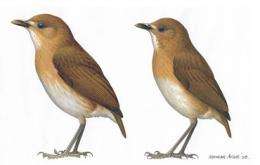New bird discovered after its extinction

After almost 120 years in the Natural History Museum collections, a new Colombian bird has been discovered, and proclaimed extinct.
The bird is a new subspecies of antpitta, a thrush-sized ground-living flightless bird from forests near the Colombian city of Medellin.
It was discovered among the 1 million bird specimens at the Natural History Museum in London, after lying unrecognised in the collection for 120 years.
Bird artist Norman Arlott uncovered the specimen in 2001 and drew it to the attention of Museum's Head of Bird Group, Dr Robert Prys-Jones, and Museum scientific associate Dr Paul Salaman.
'We immediately recognised the specimen was previously undescribed,' says Dr Salaman, 'yet it seems inconceivable that this distinctive specimen could have had been overlooked for 120 years.'
Collected more than 100 years ago
The bird was originally collected in September 1878 by the British ornithologist Thomas Knight Salmon.
'There were no bird identification guides in the late 19th century,' says Dr Prys-Jones.
'So Thomas Salmon sent the specimens he’d collected to be identified by scientists in Britain, where many were deposited at the world’s largest bird collection here at London’s Natural History Museum.'
'While there were many new and exciting discoveries, one unusual specimen of an antpitta was amazingly overlooked.'
Habitat gone
The new bird, called Antioquia brown-banded antpitta (Grallaria milleri gilesi), lived in the Andean mountains at Santa Elena, a neighbouring town to Colombia’s third largest city, Medellin.
Formerly forested, with their cool climate and rich soils, these are prime locations for coffee cultivation, agriculture and cattle grazing. Very little of the original forests remain and the region has very few protected areas.
Bird search
Recent searches by Fundación ProAves, Colombia’s national bird conservation organisation, have failed to locate any living individuals so in the wild the bird is probably extinct.
'Sadly, the new subspecies appears to have been restricted to Andean forests,' says Dr Prys-Jones 'a habitat that has been almost completely destroyed around Medellin and replaced by non-native pine trees and exotic eucalyptus trees.'
'If we had known about this extraordinary specimen decades before, it is possible the bird could have been located and saved. But sadly it lay overlooked for generations and as a bitter consequence we have probably lost it forever,' concluded Dr Salaman.
The description of the new bird is published in the March 2009 issue of Bulletin of the British Ornithologist’s Club.
Research took place as part of Project BioMap, funded by the UK Darwin Initiative and Conservation International to database all Colombian bird specimens held in museums worldwide.
Provided by Natural History Museum















